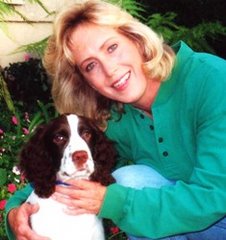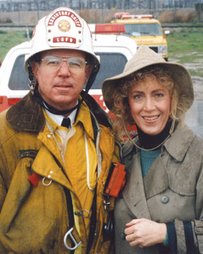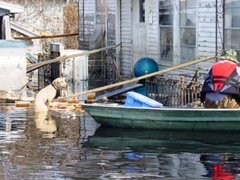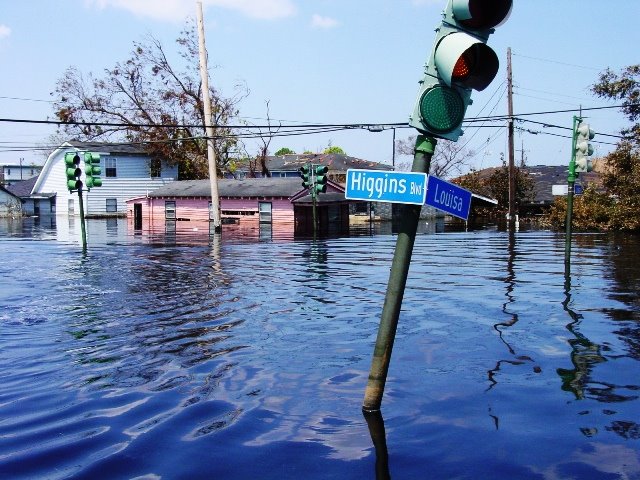LifeWriters Talk About LifeWriting
Nancy Rigg: Her Story Helps Save Lives
(09/04, Vol. 8, Number 3)
In 1980, Nancy Rigg had recently moved to Los Angeles CA from Colorado with her tall, handsome fiancé, Earl Higgins. They were looking forward to marriage and to working together as writers and filmmakers. But unprecedented floods in February swept away her fiancé and her dreams and changed Nancy's life forever.
Torrential rains had been battering LA for several days, but finally the sky cleared and Nancy and Earl took their dog for a walk. As they crossed a high footbridge spanning the flood-swollen Los Angeles River, Earl and Nancy saw a 12-year-old boy jump into the roiling water to recover his bicycle, which had been caught by the powerful current and pulled in. In a moment the boy was being swept away. Earl ran to the edge of the river to try and save him, but, when he too stepped into the water, he was quickly swept downstream to his death. (Nancy vividly describes the events of that fateful day in her article in the February 2001 issue of the Story Circle Journal.)
Nancy has devoted the past 20 years to promoting swiftwater rescue safety throughout the US and to educating the public about the dangers of flood waters. Just this summer, the TV show "Tactical to Practical" on the History Channel featured a segment on swiftwater rescue and included an interview with Nancy.
At our February 2004 Story Circle Conference, Nancy was the facilitator for the panel on "The Power of Story." In this interview, Nancy talks about the different ways she has told her story and how she has used its emotional power to create change.
Story Circle Journal: In your account of the events surrounding Earl's death, you tell how you were suddenly faced with the question: "Who am I now that I am no longer 'Earl and Nancy'?" How were you able to answer this question?
Nancy Rigg: When you lose a spouse suddenly, whether it's due to death or divorce, there comes a point when you discover that you need to redefine yourself now that you are no longer a 'couple'. This is true even with the most loving and independent couples. For me, a piece of my heart disappeared with Earl down that river and the impact was profound on many levels, including my identity.
When you love someone deeply there is a subtle blending. You mesh on so many levels, that having that person torn away from you abruptly represents loss on many levels. I never realized until he was gone how much Earl and I had blended. Losing him meant losing an intrinsic connection to myself. For this reason it was a shock when I found myself staring at a stranger in the mirror after Earl died.
It took time for me to understand that with or without my partnership with Earl, I still had a lot of useful work to do during my time left on earth.
SCJ: In the months right after Earl's death, what was the usual reaction to your story and how did you deal with the reactions that you got?
NR: Because Earl and I had moved to Los Angeles only six weeks before he got killed, I did not have a wide group of friends or family living here who could lend support and quietly listen when I needed to talk. Although Hollywood routinely exploits tragedy, people in the film business aren't "allowed" to experience it themselves.
Earl and I had moved to LA to build careers in mainstream Hollywood film and television production, but we had not yet become established in our careers when he died. In fact neither of us had found a job yet. After Earl was swept away, I was determined to remain in the area until everything related to his death was resolved, including the recovery of his remains. Because this was a prolonged process that ended up taking nine months, I needed to keep myself afloat financially, so I had to get out and look for work. This proved difficult on many levels, not the least of which was that grief hovered over me like a huge, black cloud.
Being an "unmarried widow" also put me in an unusual position as I moved into the world again. I found that being a real-life tragic heroine is anything but welcome at film screenings, job interviews, and dinner parties. The common response in those early days was, "Oh, your boyfriend died? That is so sad, but you're young, you'll find someone new."
Rather than attempt to reason with people who were clearly clueless about matters of life and death, I eventually learned to bear my sorrow in silence. My journal became my lifeline, because part of the healing process involves expressing what happened, working through the grief, exploring the trauma, and charting a future course through life. Those first nine months after Earl disappeared and before his remains were finally recovered were the loneliest I've ever known in my life.
SCJ: Tell us how you began to tell your story in the media.
NR: The first time I wrote an article about Earl's death and its powerful lessons was when the first anniversary of his death was approaching in 1981. It was the rainy season again and a crushing sense of grief and concern was consuming me as torrential rainstorms slammed into LA again. I knew that other children and would-be rescuers were still at risk and, unless warnings were sounded, someone else was going to get killed. Compelled to speak out, I wrote an article begging parents to warn their children to avoid flood-swollen rivers and flood control channels.
I was so determined to be heard that I called the Los Angeles Times, got the name of the op-ed editor, and drove downtown to hand deliver my typed article to her! I'll never forget the astonished look on her face. But time was of the essence and I was determined not to have my story lost in the "unsolicited manuscript" pile. This article, called "A Valentine to One Who Cared," was published as a guest editorial on Valentine's Day 1981.
Because of the article, I was contacted by the LA County Lifeguards, who had been trying for years to implement an inland flood rescue program. It was through meeting with the lifeguards that I launched my quest to establish a comprehensive swiftwater and flood rescue program in LA, never realizing what a monumental and lengthy task it would be.
When we entered a seven-year-long period of drought, my efforts all but dried up. I focused on healing and moving ahead with my life but I always knew there would be another trip-wire that would re-open the issue of swiftwater rescue.
SCJ: How did your story help reopen public awareness of the need for swiftwater rescue?
NR: In 1992, as the 12th anniversary of Earl's death approached, the long seven years of drought ended with torrential flooding and a 15-year old boy named Adam Bischoff was swept down the Los Angeles River in a journey hauntingly similar to Earl's. This time, due to advances in technology, the haphazard, scrambled rescue attempt aired live on television, clearly showing that rescuers had no plan in place to deal with incidents like this. Emotionally shattered, I paged through my old grief journals and found the name of the county lifeguard who had contacted me ages ago and called him. He asked me, "Will you speak out; will you tell your story?"
The LA City Council was pressed into holding public hearings. This marked the first time I spoke out before a government body. I was later told that my personal testimony had an immediate, profound effect on political leaders and emergency responders alike. If these hearings had ended up being a one-shot deal to placate the community before things went back to the old status quo, the swiftwater rescue program would never have been developed. My testimony evidently helped propel the issue forward.
SCJ: You began being asked to do TV interviews.
NR: Yes. As a result of television and newspaper interviews coordinated by the LA County Lifeguards, I found myself serving as a spokesperson for the many families of victims who had lost their lives in swirling floodwaters. Adam Bischoff's family also contacted me and asked to join with me to create change. Together, we took on the LA City Council and County Board of Supervisors to raise awareness and secure funding for the pioneering LA County Multi-Agency Swiftwater Rescue Task Force, the first of its kind in the nation.
Drawing on my background as a writer and documentary filmmaker, I was asked to produce the first flood safety education video aimed at educating children about the dangers of fast moving floodwaters. This video, No Way Out, was distributed to schools throughout LA County and is still in use today.
SCJ: What opportunities and challenges did TV offer you?
NR: As I focused on ensuring that our new swiftwater rescue program survived budget cuts and other pressures that threatened to derail it during those first few years, the cable television industry "discovered" a new market that I call "rescuetainment," mining "exciting" television news footage and re-telling rescue stories. As a result, I found myself serving as the subject of several documentary TV programs focusing on flooding. I also co-produced a special for the Discovery Channel, which helped propel swiftwater and flood rescue onto the national stage.
I've always tried to remain open to opportunities to share my personal story in an effort to create awareness and change. But I've been very selective when choosing whom to work with and be interviewed by to avoid having Earl's last moments on earth be exploited for the sake of "rescuetainment" only. I've long been relieved that his death was not captured by news cameras back in 1980. It was bad enough to lose Earl once, but to have his death replayed again and again would have been tormenting.
SCJ: You've also told your story before Congress.
NR: That was in 2000. I was asked by a US Congressman to appear as a witness before a Congressional sub-committee that was studying why so many lives are lost in floods and what can be done to reduce the death toll. Standing before this committee in Washington, DC, one day before the 20th anniversary of Earl's death was like coming full circle.
I never intentionally set out to become a national spokesperson for flood safety education and swiftwater rescue. But someone needed to speak out for those whose voices were silenced too soon. Other families were unable or unwilling to step forward, so the task fell to me. I am proud to have allowed my personal story to be a transforming event that is now helping to save lives not just nationwide, but worldwide.
SCJ: How do print and visual media differ, in your experience?
NR: I love both the written word and the world of moving images. With words, you paint pictures that are powerful and compelling. You, and a good editor and publisher, are in charge of how the story will be presented. The process is relatively self-contained.
Unless you're a celebrity, with automatic name recognition, or you have the means to self-publish, it is a challenge in today's market to get a personal memoir published. I'm still working on this.
In documentary film and television production, the spoken word is important, but visual images really carry the story. The danger with television news footage is exploiting tragedies that belong to other families. As a writer, producer, and director, I have to approach this work very mindfully and carefully. Unfortunately, the entertainment industry is not known for its mindfulness, so creating meaningful, personal documentary projects is also a challenge.
Film and television production is also more collaborative than writing for the print media. Unless you're independently wealthy and can have the final say about how the program lays out, your work is subject not only to budgetary constraints, but also to opinions and input from every executive and filmmaker wannabe working up and down the production food chain.
Any meaningful creative project includes intrinsic challenges. When you make the leap from an idea to full production or publication, you simply have to be persistent and make choices based on your personal sense of integrity. As an artist, I believe in truth and simplicity. Regardless of whether it's a television or film documentary, a newspaper or magazine article, or a published book, I believe in letting the story tell itself. Keep it simple. By that I mean: you don't need to clutter up your documentary with fancy special effects or a thundering underscore or to twist what people say out of context to fit your preconceived notions. The same applies to articles and books. Keep it simple.
SCJ: Tell us about a time when your story had an immediate and profound effect on your listeners and changed their actions?
NR: I was asked to speak to a fire department that was in the process of developing a new swiftwater rescue program. The fire captain encouraged me to go into detail about how I was treated by on scene firefighters when Earl disappeared.
I quietly recounted how I was first yelled at by the firefighters who had to use bolt cutters to free me from the fenced-in area downstream where I had run along the levee, chasing after Earl and the boy, dragging my poor English Springer Spaniel behind me.
Then they totally ignored me while they joked and drank coffee leaning casually on their fire engine. They left me shivering with emotional shock and mild hypothermia in a downpour of rain, with no umbrella, jacket, blanket, or other protection, waiting for news of the rescue operations.
And when they finally called off the search and the fire engine pulled away, they left me standing alone by the river in a city I was totally unfamiliar with, stranded more than two miles downstream from where Earl entered the water, with no money, no keys to the apartment (our keys were in Earl's pocket) and no friend or family member to call for help.
About a week after recounting this story, the fire captain called and said, "You've ruined them! After listening to you talk, my guys have never been nicer. They can't do enough for the families of patients we transport to the hospital or when we go on a rescue call. They're taking too long to get the work done and they're driving me crazy!" We both had a good laugh over this.
To their credit, the majority of emergency responders in today's world are far more attuned to the needs of "secondary victims," including witnesses and family members, even as they make every effort to attend to the "primary victim," the actual person needing emergency care.
SCJ: You've talked about wanting to write your story as a way of promoting healing among survivors of disasters. And you were instrumental in advocating for fiancés of survivors of 9/11. Tell us more about this.
NR: There are virtually no personal memoirs about surviving natural disasters, let alone man-made ones like the terrorist attacks of September 11, 2001. I moderate online peer support groups for survivors of disasters and families who have lost loved ones through drowning accidents, and I can't tell you how many times people have thanked me for providing some source of guidance and solace. Publishers would do well to realize that this is truly an untapped market. And because disasters happen all the time, books guiding people through the aftermath and recovery would have solid shelf life, like books about death and dying.
In terms of reaching out to survivors in the aftermath of September 11th, the loss of more than 350 fire-rescue and law enforcement personnel hit me hard on a personal emotional level. I had met and interviewed members of NY-TF1, New York's multi-agency urban search and rescue (US&R) task force, which was absolutely decimated that day. Although I was not close to these guys in the way I've become close with many of the folks who serve on the California US&R teams, it felt like a death in the family.
But what really got to me was when television news cameras showed families and friends of those who were missing as they distributed printed flyers describing their loves ones and featuring photos of them. I'd had to do the same thing, handing out descriptions of Earl to agencies up and down the river, while awaiting news of his fate.
I started to wonder about all the young couples, like Earl and me, who were engaged, but not yet married. The week before his remains were finally recovered, nine months after he disappeared, Earl was presented with the Carnegie Medal of Honor for Heroes, posthumously, in honor of his heroic attempt to save the young boy. The medal was mailed to his parents and I was informed that widow's benefits were available only to those who were legally married. What this meant was that I had all of the responsibilities of being a legal widow and none of the "benefits." It was a tremendous financial blow on top of everything else, because Earl and I were typical of people in their 20s, totally unprepared financially to handle a sudden death.
For this reason, when the financial settlement for the families of 9/11 victims was announced, I vigorously advocated on behalf of couples who were engaged, who could clearly demonstrate their future plans together. I'm not sure how important sharing my story was at the time, but it boosted the effort to include engaged couples, as well as gay and lesbian couples, in the financial settlement process.
SCJ: What has it taken for you to heal from the pain of losing Earl?
NR: Healing is a gradual process that differs for everyone. In those early, bewildering days and nights following Earl's disappearance, I had no guidebook. Because I was not a "legal" widow, I could not participate in any local widow support groups. General grief support was inadequate due to the trauma and lack of resolution, with Earl's remains missing. My wise mother handed me a blank journal and encouraged me to chart my own course through this unknown territory. The ten "grief journals" that I filled over the next several years following Earl's death were truly a lifeline for me.
The words I scrawled on the page were like little fireflies lighting the path on my healing journey. Love was my invisible guide, as well as the fuel propelling me forward. Because I was a witness to Earl's death, traumatic stress exposure compounded what might have been a more normal grieving process. I felt compelled to remain in Los Angeles until Earl's remains were recovered, never imagining that this would take nine months. I felt compelled to speak out about the need to develop a swiftwater/flood-rescue program and educate people about the dangers of moving water, never imagining that this would become a 20-year-long effort.
In those early days it never felt like I had a choice to do this. I had to do this. I was compelled to take action by a force that was more powerful than any resistance or hesitation generated from within my own grieving heart.
I never imagined launching a rescue revolution, but that's what happened. Progress remains slow; too many swiftwater rescue programs continue to be built on the graves of victims who could, and should have been rescued if only local emergency responders had the proper training, equipment, and response planning to begin with. But playing a key role in this lifesaving effort has been the central moving force in my own healing process.
SCJ: What is the strongest life lesson you have drawn from losing Earl?
NR: When you lose a loved one suddenly and traumatically, the "why" questions can consume you. The trauma itself can become a defining force and sometimes you feel powerless standing in its shadow. The morning after Earl was swept away there was a knock on my door. I opened it and found my father and mother standing there. They had flown in from Colorado to give me support and assistance. It was a tremendous moment, knowing that I did not have to face the immediate aftermath alone.
After a teary reunion where, for the first time in my life, I saw my father cry, he asked to see where Earl disappeared. He needed to do reconnaissance, to see what we were up against. We walked to the footbridge spanning the river, which was still churning with runoff, like a flash flood in a box. As we stepped onto the levee, the cold truth hit me hard. The roiling water was a force beyond what anyone could survive and I knew beyond the shadow of a doubt that I would never see Earl alive again. My knees buckled and Dad grabbed me as I shuddered and cried, "Why? Why did this have to happen? Why did Earl try to rescue a child from this kind of water? Why did he die, when the child survived?"
"When I was on Okinawa," my dad said quietly, "we were in a firefight that was like this river. Relentless. Unstoppable." Before this moment in time, Dad had never spoken of his experiences as a Marine in World War II. As I quietly sobbed while he held me tight, he added, "My buddy to the right took a bullet. The guy behind me dropped. Another guy next to me was hit. Three guys to my left were gunned down. When it was all over, I was one of the only guys left standing. Nancy, you may as well ask why I'm alive as why Earl's dead."
In that instant, the why questions dissipated forever.
But my father had wisdom beyond the why questions. He looked me in the eyes and said, "This may be a defining moment in your life, but it is not the defining moment. This tragedy is not who you are or who you will become. Like someone coming home from war, you now have some hard choices to make. Don't ever let this moment keep you from living the life you were born to live."
In the safe embrace of my family, I learned that love is more powerful than any force in the universe. It transcends time and space and reaches beyond Death's door. It is not the pain that matters. It is not the trauma or tragedy. It is how you choose to relate to it. If you cling to the truth and allow love to be your guide, no matter the pain, you will never go wrong.
I would encourage others who have endured traumatic experiences to be brave and write what is true and healing. You never know how your life story may inspire others who are struggling with similar issues to find the fortitude to move down a healing pathway instead of one that is self-destructive.
—Email interview conducted and edited by Jane Ross
About 'LifeWriters Talk About LifeWriting'
"LifeWriters Talk About LifeWriting" is a series of interviews with LifeWriters published in the Story Circle Journal. The Story Circle Network is a non-profit organization that honors women's voices, celebrates women's lives, and encourages women to tell their stories. To learn more about this unique organization, go to www.storycircle.org; to become a member, go to www.storycircle.org/frmjoinscn.shtml.
For information about the series or the Network, contact us via email:
storycircle@storycircle.org or phone: 512-454-9833 or write to:
Story Circle Network P.O. Box 500127 Austin, TX 78750-0127
Subscribe to:
Post Comments (Atom)





No comments:
Post a Comment